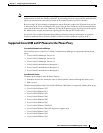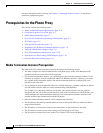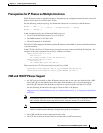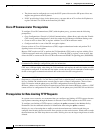
17-8
Cisco ASA Series Firewall ASDM Configuration Guide
Chapter 17 Configuring the Cisco Phone Proxy
Prerequisites for the Phone Proxy
If NAT is configured for the TFTP server or Cisco UCMs, the translated “global” address must be used
in the ACLs.
Table 17-1 lists the ports that are required to be configured on the existing firewall:
Note All these ports are configurable on the Cisco UCM, except for TFTP. These are the default
values and should be modified if they are modified on the Cisco UCM. For example, 3804 is the
default port for the CAPF Service. This default value should be modified if it is modified on the
Cisco UCM.
NAT and PAT Prerequisites
NAT Prerequisites
• If NAT is configured for the TFTP server, the NAT configuration must be configured prior to
configuring the TFTP Server for the phone proxy.
• If NAT is configured for the TFTP server or Cisco UCMs, the translated “global” address must be
used in the ACLs.
PAT Prerequisites
• When the Skinny inspection global port is configured to use a non-default port, then you must
configure the nonsecure port as the
global_sccp_port+443.
Therefore, if global_sccp_port is 7000, then the global secure SCCP port is 7443. Reconfiguring the
port might be necessary when the phone proxy deployment has more than one Cisco UCM and they
must share the interface IP address or a global IP address.
Note Both PAT configurations—for the nonsecure and secure ports—must be configured.
• When the IP phones must contact the CAPF on the Cisco UCM and the Cisco UCM is configured
with static PAT (LCS provisioning is required), you must configure static PAT for the default CAPF
port 3804.
Table 17-1 Port Configuration Requirements
Address Port Protocol Description
Media Termination 1024-65535 UDP Allow incoming SRTP
TFTP Server 69 UDP Allow incoming TFTP
Cisco UCM 2443 TCP Allow incoming secure
SCCP
Cisco UCM 5061 TCP Allow incoming secure
SIP
CAPF Service (on Cisco
UCM)
3804 TCP Allow CAPF service for
LSC provisioning


















